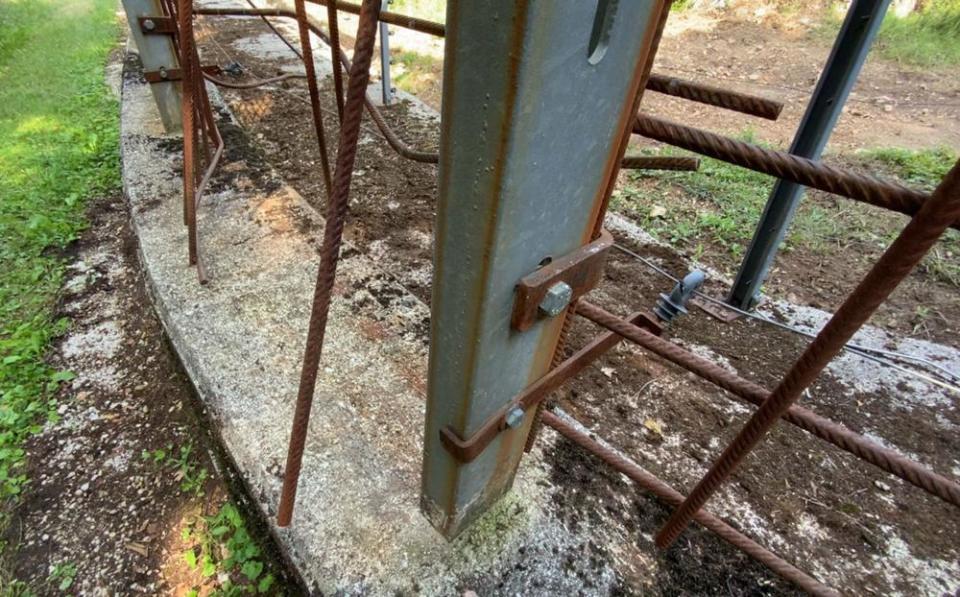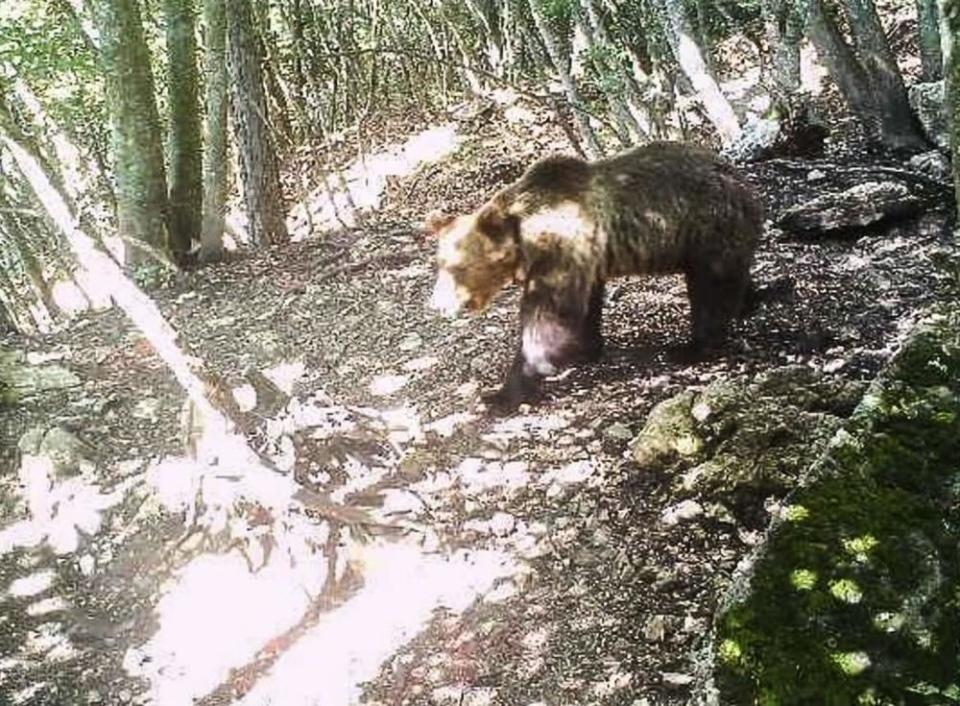Papillon the bear: how the 'escape genius' sparked a national debate in Italy

Once one of Europe’s ‘most wanted’ wild animals, the now incarcerated bear has become symbolic of the conflict over the reintroduction of large predators
The prisoner is in a cage measuring two by six metres, surrounded by three 7,000-volt electric fences, a four-metre-high barrier, CCTV and a number of rangers. From afar, the structure resembles a maximum-security prison or even the T rex enclosure in Jurassic Park. The inmate is not, however, an oversized reptile or a Sicilian mafia boss, but a bear. His code name is M49, AKA Papillon, and until his capture last month, he was Europe’s most wanted wild animal, accused of having slaughtered dozens of cows and sheep in the mountains of northern Italy.
Papillon, weighing 149kg (23st), is considered by the authorities to be an “escape genius”. He was recaptured by Italian rangers on 7 September having fled six weeks earlier from his enclosure at the Casteller wildlife centre, south of the city of Trento. The enclosure had previously been reinforced after Papillon had escaped three times. Another escape would be a public embarrassment for the authorities, which means that since 7 September, Papillon has been locked up, an official source told the Guardian.

The story of Papillon, who was eventually caught two weeks after another young male bear attacked a police officer in Trento province, has rekindled the debate about the reintroduction of brown bears into the region.
‘What about the cows and sheep?’
Bears are at the centre of culture and history in the Trentino-Alto Adige region. One of the area’s heavenly protectors is Saint Romedius, a fourth-century hermit who is often depicted with a bear by his side. Legend has it that the horse Romedius was riding while en route to Trento to meet the bishop was mauled by a bear. The hermit tamed the bear and rode “bearback” to his destination.
Intensive hunting that began in the 17th century greatly reduced the number of brown bears in Italy, as city governors paid hunters handsome sums to kill the animals. By 1998, there were only four bears left wild in Trentino.

With the bears close to extinction, the Life Ursus project, which has European Union funding, was launched to reintroduce bears into the region.
“They brought into Trentino nine bears from Slovenia – three males and six females,” says Osvaldo Negra, a zoologist and World Wide Fund for Nature representative in Trento. “In the early 2000s, the first cubs were born. Since then, the population slowly but surely climbed until it reached 60 bears. In 2010, the Life Ursus project was declared successfully concluded.”
Everything seemed to be on track, but the reintroduction of the animals into the Adamello Brenta nature park soon reignited the traditional battle between humans and bears.
“The bears began moving from one area to another,” says Ornella Dorigatti, Trento’s representative for the International Organization for Animal Protection (OIPA). “They reached the limits of some villages and, given the lack of food in the mountains, they began preying on livestock, which roam free in these valleys.” Today, herders who lose their livestock are reimbursed up to €1,200 (£1,087) per animal. But the conflict over the bears continues.
“The bears are compromising our livelihood in these valleys,” says Giacomo Broch, 43, president of the Herders Association in the province of Trento. “The recompenses are fine, but up to a certain point. Our cows and sheep are not just numbers. Each one has a name and a history. Everyone wants to defend the bears, but why doesn’t anyone consider the helpless cows and sheep that are mauled by these carnivores?”
Broch adds: “We need to contain their numbers. And when I say contain, I mean put down.”
When the attacks started becoming more frequent, as the number of bears increased, special armed “anti-bear” squads were formed to capture and, if necessary, shoot any bears considered “potentially dangerous”.
In 2012, a six-year-old bear code-named JJ5, accused of having attacked numerous farm animals, died after being sedated. Its stuffed remains are on display on the third floor of the city of Trento’s science museum. In 2014, Danzia, a mother of two cubs, died from being tranquillised after being caught for allegedly attempting to attack a man. In 2017, rangers killed KJ2, a female accused of attacking a man in the woods. Other bears ended up behind fenced enclosures, while about 10 simply disappeared.
“The solutions to protect the herders exist,” says Negra. “There are electrified fences and guard dogs. The authorities have instead taken an approach that I call ‘western’, in which bears are considered hardened criminals who deserve to be locked up.”
‘Our ancestors got it right’
In 2018, Maurizio Fugatti, a member of the far-right League party, was elected president of the autonomous province of Trento, thanks in large part to support from herders. He gave the order for rangers, if necessary, to shoot on sight bears deemed to be a danger.
Top of his list was the four-year-old M49 – the 49th male bear born in Trentino – which had gained legendary status in the region. Claiming that he was responsible for attacking dozens of farm animals, Fugatti ordered that he be caught, and on the evening of 14 July 2019, the bear was taken into custody.
The day after his capture, M49’s cage was empty. The bear had managed to climb over three electric fences and a four-metre-high barrier before disappearing into the woods. Fugatti granted permission for rangers to shoot the bear if it came close to inhabited areas. “The fact that the bear managed to climb over an electric fence with seven wires at 7,000 volts demonstrates that this specimen is dangerous and a public safety problem,” Fugatti said at the time.
The great escape earned M49 the name Papillon, after the eponymous character from Henri Charrière’s memoir about escaping from a French penal colony, which was released as a film in 1973 starring Steve McQueen. The animal was recaptured on 29 April this year, but remained in captivity for only two months before escaping again. After again being caught, its enclosure was reinforced, and the bear was fitted with a radio collar to monitor its movements. It was all in vain, as Papillon, who had already become a symbol of freedom and a champion of the force of nature over humans, managed to escape once again on 27 July and remove his collar.
While on the run, Europe’s most wanted bear crossed the Fiemme Valley, where the Varesco brothers’ cows were grazing. The Varesco family have been herders for three generations. On the night of 14 August this year, the fugitive bear allegedly killed four of their cows. “He killed them all, but he ate only the unborn calf of one of the heifers,” says Mauro Varesco. “Around here, up to a few decades ago, people would receive prizes for hunting bears. Our ancestors got it right.”
Papillon’s time on the run came to an end last month. An official source at the Casteller centre, where the animal is currently detained with two other bears, said Papillon now spends his days in a cage, and that in the first weeks of detention, veterinarians administered tranquillisers to calm him. Fugatti and the authorities in Trento did not respond to requests for comment from the Guardian.
Related: Papillon the bear must be set free, says Italy’s environment minister
The Italian environment minister, Sergio Costa, has since declared that the animal must be returned to the wild. But on Facebook, Costa said the national government had little authority over Papillon’s future, as the province of Trento’s autonomous status granted it the right to decide the bear’s future.
“Between an M49 locked up his entire life and a dead M49, as a zoologist I prefer euthanasia,” says Negra. “I consider it a more suitable solution for a wild animal.”
Even if Papillon is released in the coming days, animal rights activists are poised for an ongoing legal battle against the authorities over the region’s bears. “The bears must be kept free,” says Dorigatti. For the past 10 days she says she has been on hunger strike to protest Papillon’s incarceration.
“The Trentino region secured funds from the European Union to reintroduce bears. And just as the number of bears in this region has begun to stabilise, they want to eliminate them because they believe there are too many,” says Dorigatti. “These woods belong to the wolves, bears and deer,” she adds. “We humans are just guests.”
On the other side of the argument are the herders and shepherds who have lived in these valleys for generations and have no wish to share them with large predators. In the middle, there is Papillon, enclosed in a two by six-metre cage, and the question of whether the reintroduction of species in Europe can work.
“The return of large predators to Italian forests, but also in central Europe, is an enormous challenge,” says Marco Galaverini, species and habitat conservation officer at WWF Italy. “We mustn’t forget that these species are very charismatic, and it takes a specific know-how to live alongside them so that the benefits of their re-introduction are shared by everyone, but above all to avoid unpleasant encounters with them.
“For years, we have been working on a project with European partners in the Mediterranean called Life Arcprom, whose goal is to improve the coexistence between humans and bears in order to prevent the risk of close encounters and to avoid damage to herders.
“In essence, a gunshot cannot resolve our coexistence with bears.”
Find more age of extinction coverage here, and follow biodiversity reporters Phoebe Weston and Patrick Greenfield on Twitter for all the latest news and features


